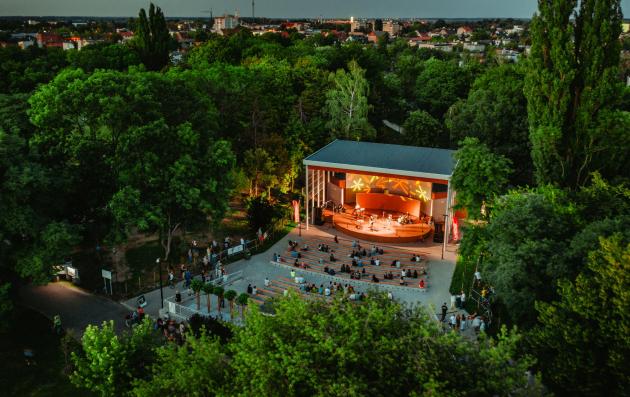Date of label : 29/10/2024
-
Ostrów Wielkopolski , Poland
-
Size of city : 70.000 inhabitants

Theatre in the middle of a green area.
Summary
The city of Ostrów Wielkopolski (PL) has undergone a comprehensive revitalisation process. The goal was to create a friendly space for residents, taking into account green areas and pedestrian zones. The revitalised city centre has gained a new character, with recreational areas created for both children and adults. An important element of the transformation were parallel activities carried out under the “Revitalisation participatory budget”. This social innovation, drawing on a dedicated pool of funds allocated in the city's budget, promotes community activities in the revitalised zone. The aim was to return this zone to its inhabitants, by involving them in creating a friendly and open city.
The solutions offered by the Good Practice
In 2020, under the "Revitalisation of the urban space" project, the city secured EUR 2 million of EU funding. This enabled the city centre to be comprehensively revitalised, including the creation of the Ostrow Local Activity Centre, the modernisation of the Amphitheatre, and the upgrading of the Ogrodki Jordanowskie playground.
The renovation of the main pedestrian street enabled it to be turned into a 'living street’ (prioritising pedestrians and cyclists over cars), creating a more pedestrian-friendly space in the city centre, where performances, outdoor cinema, and concerts are held.
In 2022, the city launched green-blue investments to modernise city centre areas like Sybiracy roundabout and square, and Głogowska Street. This area was enhanced with the planting of 34 trees, 7 000 shrubs and 16 000 perennials, and the renovation of the monument commemorating Poles deported to Siberia between 1939 and 1956.
In 2023, the city’s green transformation focus shifted to Słowackiego Avenue, with the planting of 16 new trees, 4 000 rose bushes, and the installation of a watering system, as part of the creation of urban green corridors.
In 2024, revitalisation efforts focused on Kilinski Park, the Bank roundabout and Dommed Soldiers Square.
Building on the sustainable and integrated urban approach
The revitalisation of Ostrów Wielkopolski integrates environmental, social, and cultural dimensions.
Environmental: The city centre was modernised with green-blue investments, which involved planting trees, shrubs, and perennials, creating a greener, more sustainable urban environment.
Social: The Revitalisation Participatory Budget resulted in residents becoming more engaged in more social and cultural activities in revitalised areas, boosting local community life.
Cultural: Enhancing cultural heritage with murals, neon signs, and commemorating historical figures like Krzysztof Komeda and Fryderyk Chopin.
Based on participatory approach
The Revitalisation Programme 2016-2023, led by Mayor Beata Klimek, was subject to open social consultations and adopted by the City Council of Ostrów Wielkopolski on 31 May 2017. Demographic, social, and economic indicators were used to design the revitalisation area.
The programme includes 104 initiatives. Some are implemented directly by the City, but many are initiatives of partners, including the District government, public institutions, municipal companies, non-governmental organisations, and private entities. By 2020, 10 revitalisation projects (4 investment and 6 social) had been completed, and 27 projects were ongoing (25 investment and 2 social).
The Ostrów Revitalisation Committee, a forum for cooperation between the Mayor, local government and the city’s inhabitants, evaluates the progress of the programme. Workshops targeted at residents were conducted in the areas to raise awareness of the revitalisation activities.
What difference has it made?
Key outcomes of the programme:
Improvement of public spaces: Modernisation of the city centre, creation of pedestrian zones, and new recreational areas have made the city more attractive and accessible.
Green and sustainable development: Planting new trees, numerous shrubs, and ornamental grasses has created greener urban spaces.
Community engagement and social inclusion: The Revitalisation Participatory Budget involved residents in decision-making and social activities, fostering community ownership through outdoor cinemas, fitness classes, and educational workshops.
New facilities: Modernisation of the Amphitheater and Playground (Ogródki Jordanowskie) provide venues for social, cultural, and recreational activities.
Enhanced infrastructure: Installation of 47 benches, 3 swings, 5 bike racks, 18 waste bins, and 7 dog waste baskets, alongside improved pedestrian spaces.
Green infrastructure: Enhancements in Sybiracy Square and Rondo Sybiraków through the planting of thousands of shrubs and perennials.
Benefits to residents: Approximately 16 798 residents (23.7% of the city’s population) directly benefited.
Benefits to the wider community: The entire population of around 70 000 people benefits from the improved city centre.
As a result of the project, Ostrów Wielkopolski has improved public spaces, more green areas, and enhanced social and cultural activities.
Why this Good Practice should be transferred to other cities
European cities face common urban challenges, such as ageing infrastructure, economic decline, social inequalities, and environmental sustainability. They also often share cultural and historical contexts, making revitalisation strategies more easily transferable.
The project contributes to:
- Sustainable Development Goals (SDGs): SDG 11 (Sustainable cities and communities), and SDG 9 (Industry, innovation and Infrastructure).
- The Urban Agenda for the EU.
- EU Territorial Agenda 2030.
The project is shaped by national governance/legislative frameworks, which provide guidelines for cities on how to plan, finance, and implement revitalisation projects. In Poland, the Act on Revitalisation (2015) outlines the principles, planning procedures, and financing options for these projects. The national legislative context offers a standardised framework that other European cities can adopt.
To transfer the project:
- Revitalisation goals can be tailored to address the most urgent needs of the local population.
- Involving local stackholders—residents, businesses and NGOs—ensures that the revitalisation efforts are aligned with the community's needs. For instance, in Ostrów public consultations and the Revitalisation Committee played crucial roles.
- As in Ostrów, practices should incorporate local cultural, historical, and social contexts, ensuring that revitalisation efforts enhance the city's unique identity.
This project can be adapted to the contexts of all medium-sized European cities facing similar problems.
